Excerpts from Jim Conrad's
Naturalist Newsletter
entry dated September 1, 2022, issued from near Tequisquiapan, elevation about 1,900m (6200 ft), N20.565°, W99.890°, Querétaro state, MÉXICO
TROMPETA
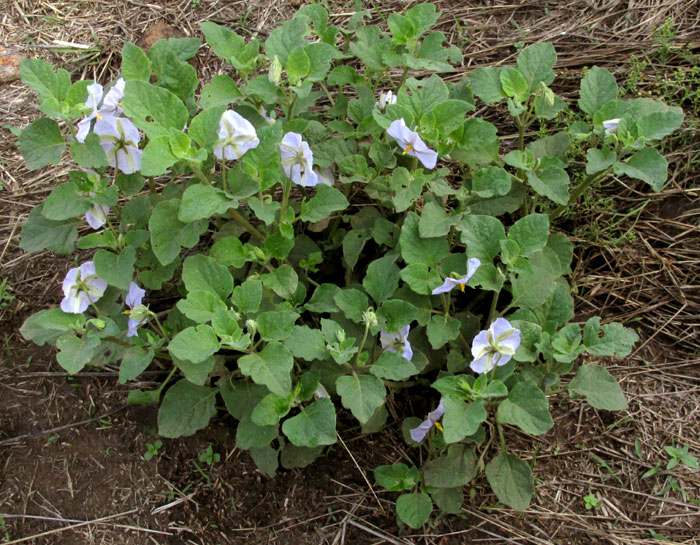
In the weedy, mosquito-rich bottom of a ravine developed along an ancient geological fault line running across agricultural fields, the above bushy, perennial herb had mostly recovered from recent floodwaters, though some of its parts were still covered with dried mud. In dim light at the ravine's bottom, the pale bluish flowers seemed to glow with their own internal light:
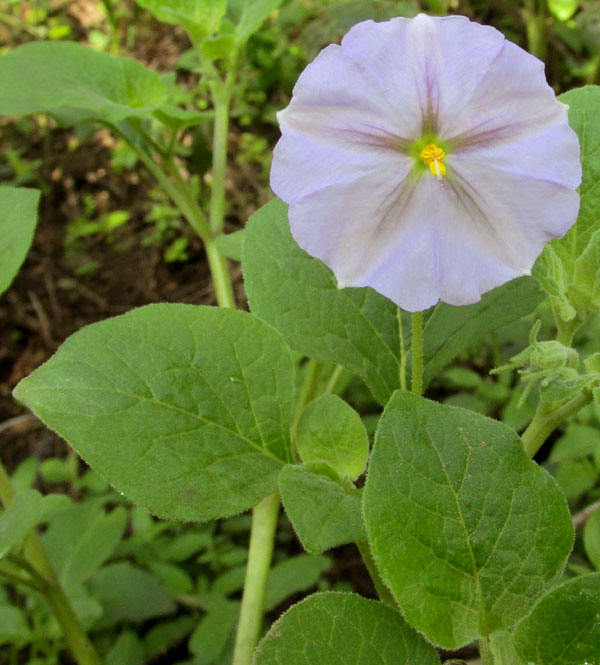
Up close, it was seen that leaves and stems were moderately soft-hairy, and flower faces exhibited a bright, yellow, nose-like center amide a star-shaped design. Recently we'd seen a similar combination of features, on the Tlanoxtle wildflower, in a prairie-like field of clumpgrass not far south of here. But this was a different species, though surely also the same genus, Lycianthes, of the Nightshade Family, the Solanaceae.
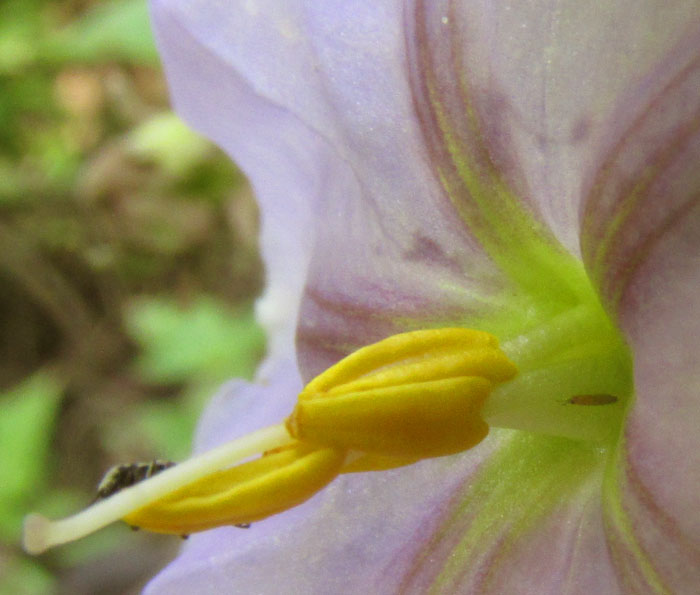
Above, the yellow "nose" shows itself as a cluster of anthers with pores at their apexes where pollen tumbles out when bees vibrate them during pollination. The lower anthers extend far beyond the others, a feature not as pronounced on Tlanoxtle flowers. In the photo, the black stuff on the lower anther is dried mud from the ravine's last flooding.
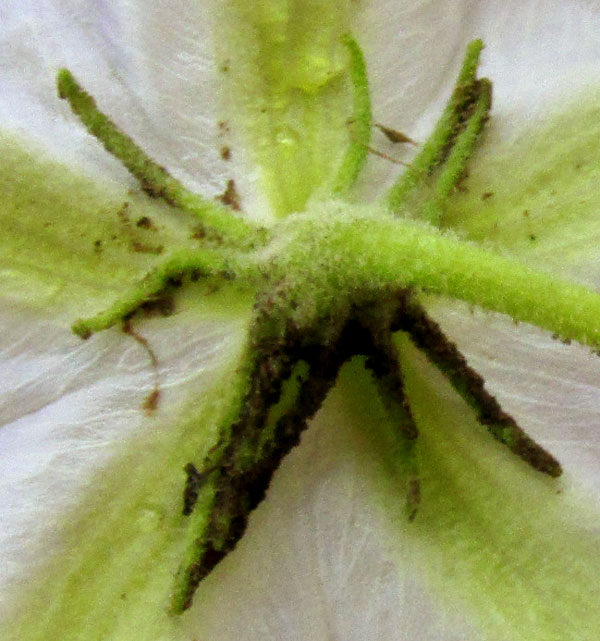
Like the Tlanoxtle, this flower's calyx, instead of five sepals, bore ten slender appendages, though these were grubby with dried mud. Also like the Tlanoxtle, these flowers grew atop unusually long pedicels:
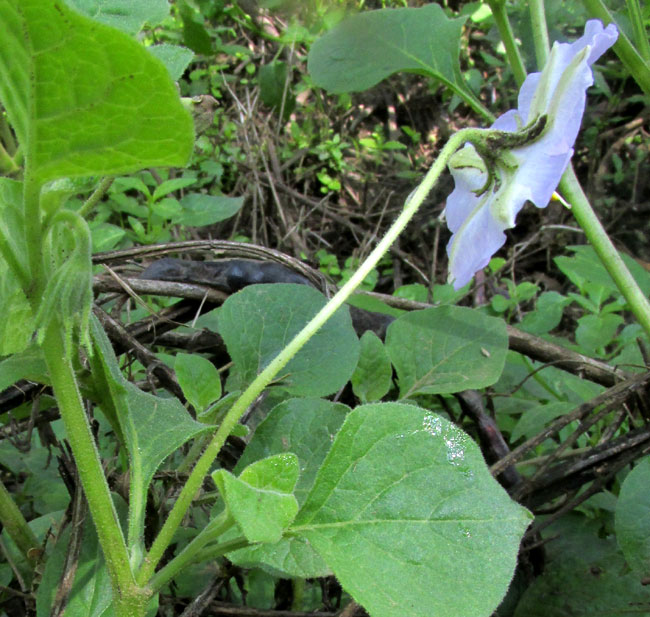
It's noteworthy that the pedicels are considerably longer than the leaves below them. Also, the leaves themselves are unusual, in that the blade bottoms abruptly constrict, forming a squarish base, while at the same time narrowly extending onto the petiole, winglike. The Tlanoxtle's leaves had been much narrower.
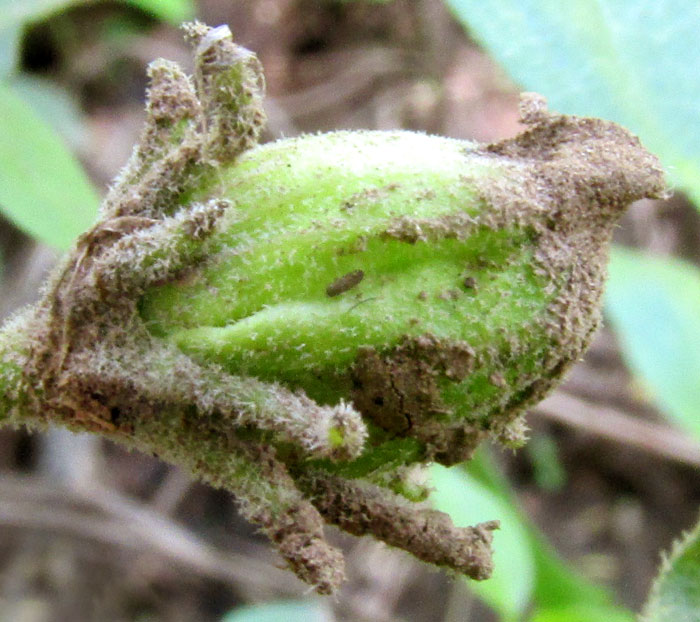
The plant bore a few immature, mud-daubed fruits. They were ribbed, a feature helping in identification, plus they were mantled with branched hairs. It turned out that the nature of those hairs was important in identifying our plant to species level. In the ravine-bottom's dim light the hair structure was hard to photograph, but certain scattered hairs on the fruit appear to bear more than two branches.
The hairs with more than two branches, the flowers on pedicels much longer than the subtending leaves, the leaves' somewhat squared, or truncate, bases, and the very unequal stamen heights all lead us to LYCIANTHES DEJECTA, closely related to our earlier Tlanoxtle. Lycianthes dejecta is endemic just to Mexico, its distribution centered in our semiarid upland region of central Mexico, but sometimes appearing as far north as Nuevo León state, and as far south as Oaxaca. Mostly it inhabits disturbed areas, including pastures, field edges and abandoned fields, at 1800-2900m (5900-9500ft). The literature emphasizes that it is mainly found on calcareous soils, but here we're on alluvium washed from fields on soils developed atop ancient compacted layers of volcanic ash and sediment from nearby rhyolite hills.
Being all-Mexican, our plant doesn't bear an English name. In Spanish it seems to be mostly known by the name trompeta, a name shared with numerous other plants with vaguely trumpet-shaped corollas, and chichi de perra, which incomprehensibly translates to "bitch of a bitch."
In traditional medicine, it's been documented as treating stomachaches in the neighboring state of Guanajuato.
Personally, it meant something to me that I could compare this new-to-me species with our earlier Tlanoxtle. It was the "savoring variations on a theme" thing, visualizing the Great Spirit evolving the Universe forward, so artfully and promiscuously improvising, refining, and doing it all with such spirit that something new, unexpected and beautiful arises, even in dank, mosquitoey ravine bottoms.
And it meant something that I as a human on little Earth am put together in a way that I see it, think about it, feel it, and am OK with the Whole Thing.